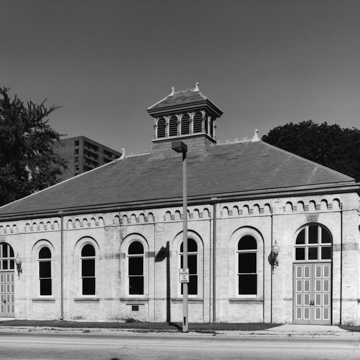Milwaukee’s river-flushing system is a marvel of nineteenth-century engineering, but this pump house is its only visible component. Inside, a massive pump draws water from Lake Michigan and sends it through a tunnel to flush the Milwaukee River of stagnant water. From here at the pumping station, the 2,500-foot-long tunnel burrows beneath the east side of Milwaukee, emptying into the river just below the North Avenue dam. When it began operating in September 1888, the pump was said to be the world’s largest, able to move 500 million gallons of water in a twenty-four-hour period. Building the pump and tunnel was the city’s largest public works project up to that time. The flushing tunnel system still functions today, typically from June to October when oxygen levels in the river are naturally low. Considerable care was lavished on the design of the cream brick pump house. Windows and doors are set into arched openings, and ornamental brick corbeling trims the eaves. The cupola ventilator with bold sheet-metal cresting crowns the slate roof.
You are here
Milwaukee River Flushing Tunnel Station
If SAH Archipedia has been useful to you, please consider supporting it.
SAH Archipedia tells the story of the United States through its buildings, landscapes, and cities. This freely available resource empowers the public with authoritative knowledge that deepens their understanding and appreciation of the built environment. But the Society of Architectural Historians, which created SAH Archipedia with University of Virginia Press, needs your support to maintain the high-caliber research, writing, photography, cartography, editing, design, and programming that make SAH Archipedia a trusted online resource available to all who value the history of place, heritage tourism, and learning.


